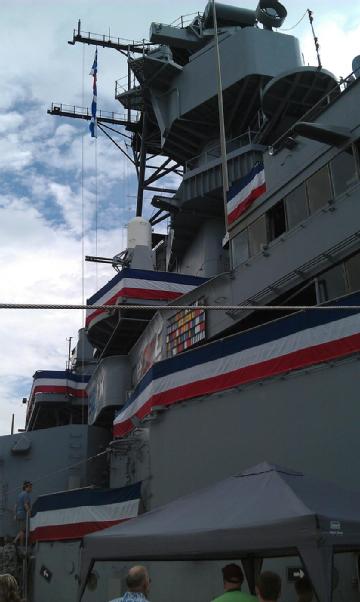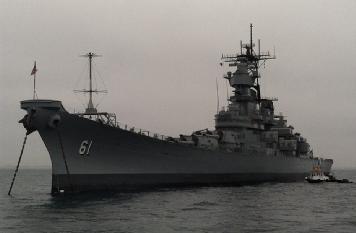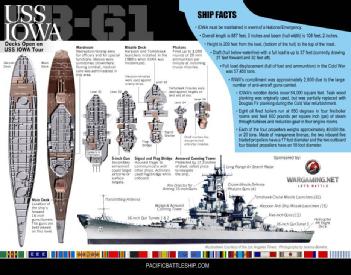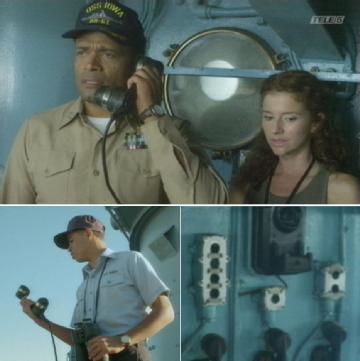
Pacific Battleship Center - USS IOWA BB-61 |
90731 Los Angeles - San Pedro, CA, United States of America (USA) (California) |
|
| Address |
250 South Harbor Blvd.
|
| Floor area | only roughly guessed: 25 000 m² / 269 098 ft² |
Museum typ
Exhibition
Military ships and submarine
- Telephone / Telex
- Radar
- Amateur Radio / Military & Industry Radio
|
Opening times
|
7 days per week, except Thanksgiving and Christmas. September 1st - June 14th: 10am - 5pm; June 15th - August 31st: 9am - 5pm |
||||
|
Status from 01/2014
|
Adult (Ages 18-61): $18; Youth (Ages 6-17): $10; Seniors (Ages 62+): $15; Active/Ret/Reserve Military (w/ID): $15 |
||||
| Contact |
|
||||
| Homepage | www.ussiowa.org | ||||
Our page for Pacific Battleship Center - USS IOWA BB-61 in Los Angeles - San Pedro, United States of America (USA), is not yet administrated by a Radiomuseum.org member. Please write to us about your experience with this museum, for corrections of our data or sending photos by using the Contact Form to the Museum Finder.
| Location / Directions |
FOLLOW "BATTLESHIP IOWA" SIGNS ON THE I-110 AND CA-47N FREEWAY. Directions From Southern (San Diego) 5 freeway north to 405 north. Take exit 37 to merge onto I-110 S toward San Pedro. Take exit 1A to merge onto CA-47 N toward Vincent Thomas Bridge/Terminal Island/Long Beach Take the South Harbor Blvd exit continue on S. Harbor Blvd. Proceed to the Battleship parking lot Directions From Northern (LA) 405 south to exit 37 to merge onto I-110 S toward San Pedro. Take exit 1A to merge onto CA-47 N toward Vincent Thomas Bridge/Terminal Island/Long Beach Take the South Harbor Blvd exit continue on S. Harbor Blvd. Proceed to the Battleship parking lot The USS IOWA is located at Berth 87 at the Port of Los Angeles. |
| Description | From Wikipedia, the free encyclopedia USS Iowa (BB-61) was the lead ship of her class of battleship and the fourth in the United States Navy to be named in honor of the 29th state. Owing to the cancellation of the Montana-class battleships, Iowa is the last lead ship of any class of United States battleships and was the only ship of her class to have served in the Atlantic Ocean during World War II. USS Iowa is currently on display at the Port of Los Angeles. During World War II, she carried President Franklin D. Roosevelt across the Atlantic to Mers El Kébir, Algeria, en route to a crucial 1943 meeting in Tehran with British Prime Minister Winston Churchill and Soviet leader Josef Stalin. She has a bathtub — an amenity installed for Roosevelt, along with an elevator to shuttle him between decks. When transferred to the Pacific Fleet in 1944, Iowa shelled beachheads at Kwajalein and Eniwetok in advance of Allied amphibious landings and screened aircraft carriers operating in the Marshall Islands. She also served as the Third Fleet flagship, flying Adm. William F. Halsey's flag at the Japanese surrender in Tokyo Bay. During the Korean War, Iowa was involved in raids on the North Korean coast, after which she was decommissioned into the United States Navy reserve fleets, better known as the "mothball fleet." She was reactivated in 1984 as part of the 600-ship Navy plan and operated in both the Atlantic and Pacific Fleets to counter the recently expanded Soviet Navy. In April 1989, an explosion of undetermined origin wrecked her No. 2 gun turret, killing 47 sailors. Iowa was decommissioned for the last time in 1990, and was initially stricken from the Naval Vessel Register in 1995. She was reinstated from 1999 to 2006 to comply with federal laws that required retention and maintenance of two Iowa-class battleships. In 2011 Iowa was donated to the Los Angeles-based non-profit Pacific Battleship Center and was permanently moved to Berth 87 at the Port of Los Angeles in the summer of 2012, where she was opened to the public to serve as a museum and memorial to battleships. Career (U.S.)Namesake: The State of IowaOrdered: 1 July 1939 Builder: New York Naval Yard Laid down: 27 June 1940 Launched: 27 August 1942 Commissioned: 22 February 1943 Decommissioned: 26 October 1990 Struck: 17 March 2006 Motto: "Our Liberties We Prize, Our Rights We Will Maintain" Nickname: "The Big Stick" Honors and awards: 11 battle stars Fate: Donated to the Pacific Battleship Center for display as a museum and memorial Status: On display at the Port of Los Angeles Notes: Last lead ship of any class of US battleship General characteristicsClass & type: Iowa-class battleshipDisplacement: 45,000 tons Length: 887 ft 3 in (270.43 m) Beam: 108 ft 2 in (32.97 m) Draft: 37 ft 2 in (11.33 m) Speed: 33 kn (38 mph; 61 km/h) Complement: 151 officers, 2637 enlisted Armament: 1943: 9 × 16 in (406 mm)/50 cal Mark 7 guns 20 × 5 in (127.0 mm)/38 cal Mark 12 guns 80 × 40 mm/56 cal anti-aircraft guns 49 × 20 mm/70 cal anti-aircraft cannons 1984: 9 × 16 in (406 mm)/50 cal Mark 7 guns 12 × 5 in (127.0 mm)/38 cal Mark 12 guns 32 × BGM-109 Tomahawk cruise missiles 16 × RGM-84 Harpoon Anti-Ship missiles 4 × 20 mm/76 cal Phalanx CIWS Armor: Belt: 12.1 in (307.3 mm) Bulkheads: 11.3 in (287.0 mm) Barbettes: 11.6 to 17.3 in (294.6 to 439.4 mm) Turrets: 19.7 in (500 mm) Decks: 7.5 in (190.50 mm) Aircraft carried: floatplanes, helicopters, UAVs Aviation facilities: none |
Radiomuseum.org presents here one of the many museum pages. We try to bring data for your direct information about all that is relevant. In the list (link above right) you find the complete listing of museums related to "Radio & Co." we have information of. Please help us to be complete and up to date by using the contact form above.
[dsp_museum_detail.cfm]
| Data Compliance | More Information |


 labattleship.com
labattleship.com 




